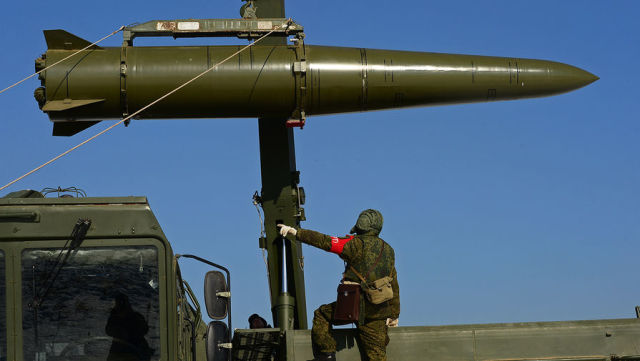Military observer of Izvestia Anton Lavrov — about what changes in the balance of forces in Europe the appearance of Iskander missile systems in Belarus
On June 25, Russian President Vladimir Putin announced the transfer of Iskanders to our closest ally. According to him, Belarus will receive an option with both ballistic and cruise missiles.
This means that we are talking about transferring to a partner in the Union State not a limited and simplified export version, but a full-fledged formidable complex that is not inferior in capabilities to those that are in service with our country and are being successfully used in a special operation in Ukraine right now.
Due to international agreements, the export Iskander-E is limited to a range of 280 km. The deployment of such in Belarus would not bring a serious increase in the NATO territory controlled by them compared to the Iskanders already available in the Kaliningrad region.
The sample, which is in service with the Russian army, has a reach of 500 km . Moreover, the termination of the INF Treaty (the Treaty on the Elimination of Intermediate-Range and Shorter-Range Missiles. — Izvestia) makes it possible to use ammunition with an even longer range on ground launchers. It cannot be ruled out that Belarus will receive them in the future.
Such a radical discrepancy in the possibilities of the export and "home" versions has long prompted the leadership of Belarus to strive to obtain the Russian version. But the issue of its acquisition, as well as the price, for various reasons remained a subject of bargaining between Minsk and Moscow for years. The dramatically changed geopolitical realities, it seems, allowed Alexander Lukashenko to get an option in the "top configuration". It is clear that in the event of a real conflict, it will be possible to use it together with the Russian Federation and according to a single plan.
Strengthening the "rocket fist" of the Union State can restrain the deployment of critically important, but easily invulnerable stationary objects of NATO military infrastructure near the borders of both Belarus and Russia. The Alliance will have to reckon with the prospect of receiving a highly accurate and irresistible retaliatory strike against them in the event of a military confrontation.
An important feature of the Iskander-M is the use of two completely different types of missiles in the ammunition at the same time — aeroballistic and cruise. The first strikes targets at a range of up to 300 km from above, maneuvering at high speed. The second one flies to the point of defeat at an extremely low altitude of up to 500 km, skirting obstacles and changing the route. This makes them vulnerable to air and missile defense.
The NATO leadership makes no secret of its plans to dramatically strengthen its military infrastructure near the Russian borders. It is planned to deploy additional military units, warehouses of equipment and ammunition here. In a few months, the United States has increased its military contingent in Europe from 60 to 100 thousand. It is planned to deploy additional international units in the Baltic States.
Iskander missiles have already been deployed in the Russian Kaliningrad region. But the additional placement of them in Belarus will give a significant increase in the reach zone, it will shift another 300 km to the south. New and existing infrastructure facilities of a hostile military-political alliance will be targeted.
In addition, the Kaliningrad bridgehead has serious drawbacks. Its limited territory is fully visible from all sides by means of NATO intelligence, the possibilities of maneuvering "Iskanders" on it are limited. The issues of accumulation and protection of ammunition are also difficult.
Belarus is much better protected from external surveillance. Complexes on its territory will have better survivability not only due to the "umbrella" of air defense, but also the ability to maneuver around the country and even beyond its borders. It is much more difficult to hunt for ground-based launchers in the vast expanses of Belarus than in the isolated Kaliningrad region. The experience of the special operation has shown that mobile long-range weapon systems are still a very difficult target to counter.
In addition to the benefits for Russia, Iskanders will strengthen the Belarusian army itself. Now its capabilities of applying high-precision remote strikes are small, there is a noticeable lag behind the Russian Federation. In the current military-political situation, an increase in the military power of an ally is in the direct interests of our country as well.
The number of Belarusian "Iskanders", which the leaders of the states will agree on, is fundamentally important. And it's not even about the number of launchers. As everyone has already understood during the special operation, it is not it that matters, but the amount of ammunition they will be supplied with. Even a small number of launchers, provided with numerous ammunition from advanced and multi-purpose missiles, can become a very serious argument in the newly escalated regional arms race with the North Atlantic Alliance.
Anton Lavrov — military observer of Izvestia
The editorial board's position may not coincide with the author's opinion

